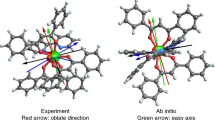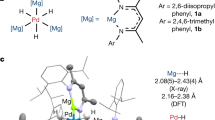Abstract
CONSIDERABLE effort has been devoted recently to the establishment of simple experimental criteria by which the stereochemistry of five-coordinate transition metal species can be recognized. They have been primarily concerned with examination of the electronic spectra and, when paramagnetic, the bulk (powder) susceptibilities. These techniques have long been used successfully to differentiate between octahedral and tetrahedral coordination in complexes. It must be emphasized, however, that this success is dependent on only these two alternative stereochemistries having been previously established. A substantial number of five-coordinate complexes of nickel(II) and cobalt(II) have been prepared and some of these have sufficiently distinctive electronic reflectance spectra to reveal their geometry. The point dipole and point charge calculations of Ciampolini1, of Ciampolini and Bettini (personal communication) and of Wood2 have provided bases for their assignment and also for the low temperature polarized single crystal spectra (unpublished work of Kohl, Gerloch and Lewis) of the molecules, M (arsine oxide)4X2 (M = Co, Ni; X = ClO4−, NO3−). By contrast the reflectance spectrum of β-Co(paphy)Cl2 may be equally well assigned3 on the basis of octahedral or tetrahedral stereochemistry although the X-ray data4 established this as five-coordinate.
This is a preview of subscription content, access via your institution
Access options
Subscribe to this journal
Receive 51 print issues and online access
$199.00 per year
only $3.90 per issue
Buy this article
- Purchase on Springer Link
- Instant access to full article PDF
Prices may be subject to local taxes which are calculated during checkout
Similar content being viewed by others
References
Ciampolini, M., Inorg. Chem., 5, 35 (1966).
Wood, J. S., Inorg. Chem., 7, 852 (1968).
Lions, F., Dance, I. G., and Lewis, J., J. Chem. Soc., A, 565 (1967).
Gerloch, M., J. Chem. Soc., A, 1317 (1966).
Van Vleck, J. H., Phys. Rev., 41, 208 (1932).
Gerloch, M., and Mabbs, F. E., J. Chem. Soc., A, 1598 (1957).
Griffith, J. S., Mol. Phys., 8, 213 (1964).
Gibson, J. F., Ingram, D. J. E., and Schonland, D., Disc. Faraday Soc., 26, 72 (1958).
Orioli, P. L., Di Vaira, M., and Sacconi, L., J. Amer. Chem. Soc., 88, 4383 (1966).
Figgis, B. N., and Lewis, J., Progress in Inorganic Chemistry, 6, 37 (1964).
Krishnan, K. S., and Banerjee, S., Phil. Trans. A, 234, 265 (1934).
Figgis, B. N., and Lewis, J., in Techniques of Inorganic Chemistry (edit. by Jonassen, H. B., and Weissberger, A.), 4, 137 (1965).
Bose, A., Mitra, S. C., and Datta, S. K., Proc. Roy. Soc., A, 248, 153 (1958).
Figgis, B. N., Lewis, J., Mabbs, F. E., and Webb, G. A., J. Chem. Soc., A, 1411 (1966).
Figgis, B. N., Gerloch, M., and Mason, R., Proc. Roy. Soc., A, 279, 210 (1964).
Jackson, L. C., Proc. Roy. Soc., A, 140, 695 (1933).
Ginsberg, A. P., and Robin, M. B., Inorg. Chem., 2, 817 (1963).
Author information
Authors and Affiliations
Rights and permissions
About this article
Cite this article
BROWN, D., GERLOCH, M. & LEWIS, J. Five-coordination and Paramagnetic Anisotropy. Nature 220, 256–257 (1968). https://doi.org/10.1038/220256a0
Received:
Issue Date:
DOI: https://doi.org/10.1038/220256a0
Comments
By submitting a comment you agree to abide by our Terms and Community Guidelines. If you find something abusive or that does not comply with our terms or guidelines please flag it as inappropriate.



